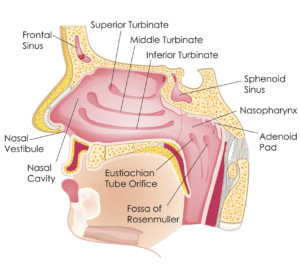Turbinate Reduction in Austin, TX
What are turbinates?

Turbinates are the structures in the nose that filter and humidify the air we breathe. Turbinate hypertrophy (enlargement) can be situational or a chronic condition. Sometimes they become too large due to one of the following:
- Allergies
- Chronic sinus inflammation
- Environmental irritants
- Septal deviation
Turbinate reduction is a simple office procedure with the capability to shrink the turbinate back to a normal size to improve the patient’s breathing.
Who is a candidate to have turbinate reduction surgery?
Any person who has persistently symptomatic turbinate swelling that has not responded to medical management is a candidate for turbinate reduction surgery. Symptoms predominantly include chronic congestion, difficulty breathing through the nose, chronic mouth breathing, associated snoring and poor quality sleep.
Patients with long-standing allergy, chronic or recurring sinus infections, vasomotor rhinitis, and polyps are typical patients that may require turbinate reduction surgery.
How Do Swollen Turbinates Effect Breathing?
The turbinate swelling fills the available space to breathe and therefore the patient feels congestion and has nasal obstruction. Many patients will get “hooked” on over the counter decongestant nasal sprays because they can temporarily shrink the turbinates. Unfortunately, this causes a rebound and worsening of the swelling. Our technique works like these nasal sprays but it permanently shrinks the turbinate by removing all of the swelling, similar to liposuction.
What are the symptoms of swollen turbinates?

- Feel as if the nose is completely blocked or will notice that one side or the other is blocked.
- Sinus Pressure
- Headache
- Mouth Breathing
- Snoring
- Chronic Congestion
If a patient feels chronic congestion causing difficulty with breathing through their nose they should have an evaluation to see if turbinate swelling is the cause. Oral decongestants or topical decongestants provide relief in turbinate enlargement but the symptoms quickly recur after that medicine wears off.
What happens if I don’t have my turbinates reduced with surgery?
Leaving your swollen turbinates as is simply means you’ll have to continue to suffer through the blockages and difficult breathing they are causing. Your partner may deal with snoring. You’ll do more breathing by mouth. Sleep quality and exercise tolerance may be reduced. It may increase the risk of obstructive sleep apnea which can create many health issues.
How Are Turbinate Hypertrophy and a Deviated Septum Related?
A patient with a deviated nasal septum is more likely to experience swollen turbinates as well. The septum is the divider between the right side of the nose and the left side of the nose. It can become bent or crooked, which is also known as a deviated septum. If your septum deviates to one side, this creates space for the turbinates to grow larger.
How Do I Prepare For A Turbinate Reduction?
It’s a simple procedure. Upon arrival at the office, we instruct our patients to take four puffs of Afrin in each nostril. The rest is up to us. It will take only a few minutes and you will be on your way.
Turbinate Reduction Patient Testimonial
 “…Dr Slaughter was the first ENT to address my deviated septum, enlarged turbinates that had me breathing through my mouth, and severe allergy issues. My surgery was quick and relatively painless…”
“…Dr Slaughter was the first ENT to address my deviated septum, enlarged turbinates that had me breathing through my mouth, and severe allergy issues. My surgery was quick and relatively painless…”
-Kelly G.
The turbinate reduction Procedure
Turbinate reduction is a simple office procedure similar to liposuction. Under endoscopic view, a small puncture is made in the turbinate that is swollen and the turbinate reduction is performed with a special instrument called a suction microdebrider. It takes about 5 minutes and IT IS DONE under IV sedation.
We frequently combine turbinate reduction with the following:
Read Blog Post: Breathe Easier With A Turbinate Reduction
How long does turbinate reduction surgery take?
These are incredibly quick procedures, usually taking about 5 to 10 minutes to perform. It is performed as an office procedure in our office on Renfert way with the patient only under IV sedation.
What is recovery like after having turbinate reduction surgery?
Patients will typically have some remaining sedation for the rest of the day of the procedure. There is some mild bloody nasal discharge for approximately 24 hours. Patients may experience some mild congestion, intermittent, progressively improving over a four week period. Typically there is no requirement for any pain medication. Patients typically can resume normal activity including work the following day.
What should I avoid doing after turbinate reduction surgery?
Fortunately there is minimal restriction after this procedure. Patients are asked to avoid bending, lifting, stooping, straining, and blowing the day of the procedure. Normal activity can typically be resumed the following day.
Will I need turbinate reduction treatment again in the future?
It is possible for a reduced turbinate to regrow, so you cannot completely rule out the need for another surgery in the future. But that would be a rare occurrence. We recommend undergoing allergy testing in our office and treating allergies with allergy drop therapy as a mechanism to prevent recurrence of turbinate swelling.

Speak With Dr. Slaughter About Turbinate Reduction!
If you are interested in a turbinate reduction and would like more information, contact our office in Austin, TX today! Call 512.601.0303 to schedule a consultation with ENT specialist Dr. Daniel Slaughter.

